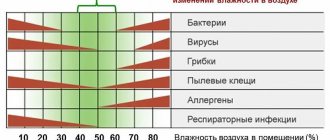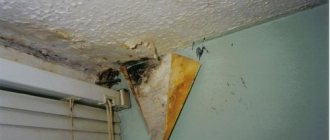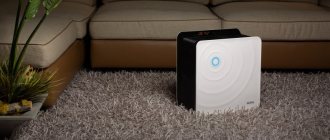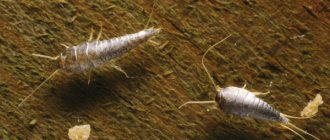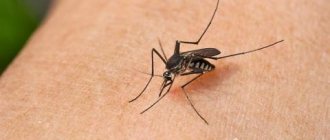Relative humidity is measured in a room - a value indicating the moisture saturation in the atmosphere. To find out the humidity in the house, you need to calculate the percentage of the maximum capacity and the actual amount of moisture. In everyday life, all complex calculations are done in a matter of seconds by special devices.
For interior design, you can use a composite board, as it does not deteriorate in any microclimate. This material consists of wood and polymers; thanks to this composition, this board is widely used in the interior: for terraces, the area around the pool, and interior decoration.
How to measure humidity level?
Maybe it just seemed to you that the air in the apartment is normal? Does your skin dry out due to improper care? To find out for sure, you need to measure the humidity level in the room. This is not difficult to do, there are even several ways:
- use a household hygrometer. This is a simple device that quite accurately and quickly determines the level of humidity. It costs literally pennies, so anyone can afford it;
- a home weather station is, one might say, a more advanced version of a hygrometer. Some models are also very affordable, but at the same time they show the temperature, can also detect pressure and use special icons to notify whether the microclimate in the apartment is comfortable;
- will do and regular glass of water, however, it will only allow you to judge whether there is a lot of moisture or little, but will not give the exact percentage of humidity. It is necessary to put a glass of water in the refrigerator for a couple of hours so that the liquid cools to 3-50C, then put the glass in the room (preferably away from the battery for the purity of the experiment) and observe. After a couple of minutes, condensation forms on the outer walls, and if it dries out over the next 5-10 minutes, then the air is dry, if it remains, everything is fine, and if it starts to drain, then the humidity is excessive;
- There is an option to use a fir cone . Let it lie in the room for a while, then watch the scales. If they have fully opened, then most likely the air in the apartment is too dry. The cone must be fresh.
Many other things indicate low moisture levels . For example, hanging laundry dries very quickly, or water in a saucer evaporates almost instantly. The problem will also be indicated by the overdried tips of the plants and, of course, your feelings. These include dry throat and eyes, a feeling of tight and dry skin, brittle, electrified hair, cough, headaches, and fatigue.
If there is still a problem with dry air, then it is better to find a solution as soon as possible. The easiest and most expensive way is to buy a humidifier, fortunately, there are a lot of them in stores. We will consider this option, but first let's try to make do with available methods.
Why is the air in the apartment dry?
In the warm season, there is no need to worry about humidity in your home; an increased amount of water in the air leads to discomfort.
In winter, the indicator drops sharply and usually in city apartments does not exceed 20 - 25%, which is lower than the indicators required by GOST.
Hot batteries are often cited as the cause. Actually this is not true. The table shows how much water vapor is contained in the air at different temperatures and different humidity levels.
Forced ventilation increases air humidity
All apartment buildings are equipped with ventilation systems, which ensure multiple changes of air in the room - dirty air is removed through the ventilation system, new air comes in from the street during ventilation, through window supply valves, gaps in doors and window frames.
For example, at a room temperature of 20 ºС, according to standards, there should be an average of 5 to 8 degrees in the air. water.
Typical winter indicators, for example, at minus 15 degrees - 80% humidity. Therefore, the air contains only 1.1 grams. moisture.
Street air, entering the room for ventilation and mixing with room air, sharply reduces the humidity level. The process occurs continuously throughout the cold months.
No. 1. Dry clothes in the room
If you previously hung your laundry on the balcony or left it to dry in the bathroom, then try hanging it in the room. Evaporating moisture will instantly increase the humidity level in the apartment, and you don’t even have to do anything special for this.
A drying rack with an abundance of hanging things in the living room or bedroom is, of course, not the best interior decoration, and for some, such a sight may even infuriate them. If you are one of them, try leaving your laundry on only overnight. Repeated moisture measurements will tell you how effective the method is in your case.
Advice - it is better to place the dryer closer to the radiator.
Instruments for measuring air humidity
You will have to decide which hygrometer device is best suited for a particular home. There are different types of hygrometers produced, which differ significantly in their operating principles.
- Psychrometric.
- Film.
- Hairy.
- Weight.
- Condensation.
- Electronic.
- Electrolytic.
- Ceramic.
Film and hair moisture measuring instruments
Hair hygrometers have been known for a long time; they are rightfully considered “old-timers” in the family of these devices. The device is designed very simply, the principle of operation is clear. Therefore, such devices remain in demand at the moment, although many homeowners prefer new types of devices.
Natural hair is used. It reacts sensitively to the slightest changes in humidity. Humidity increases - hair lengthens slightly; Humidity decreases - hair shrinks. The hair is pulled tight and thrown over the pulley. When the length of the hair fluctuates, the pulley rotates slightly. When lengthening the hair - clockwise, when shortening - counterclockwise.
The disadvantage of such a device is the significant error in readings. It reaches 10%.
Film hygrometers have a similar operating principle and design. But their sensitive element is not the hair, but the organic membrane. As humidity levels fluctuate, the size of the membrane also changes.
Psychrometric devices
The process of water evaporation is accompanied by the absorption of energy. The surface from which water evaporates begins to cool. The rate at which evaporation occurs depends on:
- from the partial pressure of water vapor in the air;
- on temperature.
Hygrometers, electrolytic, ceramic
The electrolytic moisture meter is based on the measurement of electrical resistance. A current is passed through a moisture-sensitive surface. It is coated with a hygroscopic electrolyte (thin layer). When the humidity in a room changes, the electrolyte concentration also changes, resulting in changes in electrical resistance.
Ceramic appliances also have a similar operating principle. The change in resistance is assessed taking into account changes in humidity. Here the conductor is a solid-state element. It is produced from a mixture:
- silicon;
- clay;
- koalita;
- metal oxides.
Electronic hygrometers
Such devices are presented in a wide variety. Devices of this type differ in both their external design and the principle of assessing the level of humidity measured in the room.
Another example is resistive devices. Each such device functions by measuring the resistance of a hygroscopic conductor, and this indicator changes with changes in humidity levels.
The next example is capacitive options. These devices monitor the dependence of the capacitance of capacitors (created in a special way) on humidity.
Some devices simply record the electrical conductivity of the air. Temperature indicators are superimposed on the result. And then the relative humidity is automatically calculated.
A special advantage of electronic devices is their convenience. The readings are given ready-made, unambiguous. Electronic hygrometers are produced:
- in wall versions;
- in desktop versions.
No. 2. Towels and bottles on the radiator
A simple folk method is to hang a damp towel on the radiator . The advice is effective, but you will have to change or re-wet the towel very often, because resourceful housewives once came up with the idea of dipping the tip of a towel/gauze/cotton fabric into a plastic bottle suspended from the radiator, in which they made a hole in the wall and poured water into it.
Another option is to simply hang a few water bottles behind the radiator . To ensure that the evaporation area is sufficient, it is better to make a hole in the wall rather than just unscrew the lid. The bottle can be decorated.
A more modern way is special humidifiers for the battery . The principle of operation is the same as that of simple bottles, but it will all look prettier. Such humidifiers are also filled with water, which then evaporates naturally; only the devices themselves are made of ceramics, steel, plastic and other materials. They can have almost any shape and color, so they will fit well into the interior, becoming its unusual decoration. Guests who are not in the know may not understand at all that this is a humidifier and not decor.
Tip – you will most likely need several bottles or humidifiers to speed up the hydration process.
Problems when deviating from norms
Optimal humidity indicators are determined by SanPiN and GOST standards, the time of year, the well-being of people and the purpose of the premises. A serious deviation from them in any direction inevitably becomes the cause of problems - with health or with the apartment.
What does high humidity cause?
If the average values increase by 20-30% of the established limit, then residents may encounter several unpleasant factors. These include:
- The appearance of a colony of mold fungi. Their spores exist everywhere, but mold settles only where it is comfortable - where it is humid and warm. Often such “guests” appear in kitchens, bathrooms, and in the corners of rooms. In people with asthma, such proximity causes attacks; in young children and adult family members with weakened immune systems, allergic reactions and frequent respiratory diseases are possible.
- Increased heat transfer. In the summer, in the heat of the day, high temperatures coupled with the same humidity are less tolerated by humans. The result of being in such conditions is overheating or heat stroke. High humidity is most dangerous for hypertensive patients and people with cardiovascular diseases.
In addition, when there is a large amount of moisture, furniture always suffers, especially those made of wood, finishing materials deteriorate, and things quickly become unusable.
Why is dry air dangerous?
An atmosphere lacking steam molecules is also harmful to the health of all family members (including four-legged animals).
- The mucous membranes dry out, microcracks appear in them, which turn into a free entrance for various “infections”. The consequence of weakened protection is frequent colds, various infections, exacerbation of bronchial asthma, rhinitis, etc.
- Deterioration of the condition of the skin. The rapid appearance of wrinkles, redness, irritation, and peeling are a consequence of an imbalance in the water balance of the skin. People with dermatological pathologies - psoriasis, atopic dermatitis - suffer more than others in such conditions.
- Other symptoms of excessive dry air are a constant hacking cough, frequent sore throat, itching, and eye irritation. The last symptom is more typical for people who use contact lenses.
Changes in humidity, as a rule, cannot be felt immediately in those houses and apartments where there are no measuring instruments. Unpleasant symptoms appear gradually. However, if no measures are taken, then soon all residents will begin to experience some kind of discomfort. Its degree depends on one thing - the state of their health.
No. 3. Water containers throughout the apartment
Another simple option for natural hydration. If now you have imagined buckets and basins of water throughout the apartment, and have already become desperate, then we hasten to tell you a nicer and no less effective option for organizing humidification of this kind.
A beautiful vase in a minimalist style can serve as a container . These are often used as interior decoration, so if you add another function, no one will notice. The main thing is that no one knocks over the vase. Water can be poured into a transparent container; an aquarium will do. It is not necessary to have fish (but if you want and are not afraid of care, why not), and you can decorate the container with beautiful stones, decorative algae, shells or houses - all this stuff is sold in the same place where aquariums with fish are sold. Just remember to change the water and wash the containers occasionally.
An aquarium or indoor fountain will also increase humidity.
No. 4. Open door to the bathroom
We all know that the main problem in the bathroom is high humidity. Because, as they said in one Soviet film, “those who hinder us will help us.” After bath procedures, leave the bathroom door open - let all the moisture, and there will be enough of it, go into the apartment. It turns out to be very effective - at the level of an air humidifier.
You can even leave the bath in there for a while, because this is a huge container of water that will work to our advantage. Some even advise not to turn on the ventilation in the bathroom so that more moisture accumulates. If possible, then you can take a bath or shower with the door open - let the moisture not stagnate and immediately go out into the apartment.
In the house
Often, owners of country houses and private cottages discover that the air humidity inside their homes is too high. Solving the problem is not difficult, you just need to check the operation of some systems and, if necessary, install additional equipment.
We recommend that you read: Gate for ventilation
What is recommended to do to control the microclimate in the house:
- In spring and summer, ventilate the cottage more often.
- In winter, install a heating radiator.
- Equip the kitchen with a hood, which is a good helper in the fight against unpleasant odors, and its operation also provides a flow of fresh air.
- Regularly clean the ventilation from accumulated dust.
- Buy indoor plants for your home that do not require frequent watering, for example, cacti.
- Check the serviceability of the sewer pipes and find out if there is a leak.
- Dry washed clothes on the balcony or loggia.
If your home is undergoing cosmetic renovations, you should give preference only to natural finishing materials. They absorb evaporating moisture better and dry out faster.
Another way to reduce air humidity is to purchase absorbent products. Their job is to absorb excess moisture. The products are sold in construction and hardware stores.
No. 6. Wet cleaning
Well, what would we do without her! Wet cleaning is a real salvation both in the heat, and in the struggle for clean air, and in efforts to increase the level of humidity. True, this measure alone cannot provide more than 2-3% humidity, and it requires time from you, but in combination with other measures it will work well.
No. 7. Cook more - bake less
You've probably noticed that when the kettle boils or something cooks on the stove for a long time, many surfaces in the kitchen become covered with condensation. Here it is - a free source of moisture: you cook, and at the same time you increase the humidity.
Instead of baking in the oven, try boiling or steaming more. After boiling, you can keep the kettle on the burner for a short time, using the minimum heat level - let the moisture vapor spread at least throughout the kitchen.
You can boil a large pot of water and then leave it open so that the hot steam gradually evaporates. You can add eucalyptus or tea tree essential oil to the water - they have a pleasant aroma and kill pathogens. You can add cinnamon sticks or orange peels. The most practical ones will add dumplings to boiling water and also get a hearty lunch. When you take out the finished dumplings, do not forget to leave the pan open.
Open the door from the kitchen wider, let the humid air spread throughout the apartment along with the aromas of food. The main thing is that the surfaces near the stove in the kitchen can withstand steam and condensation.
What are the consequences of exceeding the norm for indoor humidity?
Yandex.Pictures
Optimal humidity does not harm human health. The main danger even for healthy people is the appearance of harmful bacteria and microorganisms. Where it is warm and humid, colonies of fungi and mold form, the spores of which lead to allergies and asthma.
If you ignore deviations:
- Respiratory diseases will become more frequent. Diseases will take on a more severe form. Residents are at risk of bronchitis. And when, against the background of allergic and asthmatic manifestations, the disease takes a chronic form, it is extremely difficult to cure it.
- Difficulty breathing causes decreased tone. The result is a lack of performance, muscle spasms, and insufficient activity of the cerebral cortex. Attacks of suffocation interfere with sleep, which leads to fatigue.
- Unpleasant odors eat into furniture, clothes, and hair, and you won’t be able to get rid of them as long as the humidity is higher than normal. The reason for this is the results of the action of bacteria, fungal spores, mold decomposition, etc.
Yandex.Pictures
After washing, things take a long time to dry, which further aggravates the situation. Contacts and microcircuits of household electrical appliances oxidize. The TV, computer, washing machine fails, and such a case is not covered by warranty. Damp furniture becomes deformed, creaks, and cracks. Fabric upholstery, mattress, pillow, blanket takes on an unpleasant odor.
No. 9. More indoor plants
Everything is simple here. Plants need to be constantly watered, and some of them themselves provide good air humidification. These are ficus, hibiscus, dracaena, fatsia, nephrolepis or house fern, parmania or indoor linden, tradescantia, chlorophytum. You can place several small plants on the windowsill or a whole palm tree in the corner of the room. Both beautiful and practical.
No. 10. Aqua soil
These are colored balls that are actively used in gardening. They can quickly absorb water and then evaporate it. That's what we need. It is worth pouring the aqua soil into containers and placing it around the apartment. Since the balls are colored, they will not only moisturize, but also decorate the room. They need to be watered once and then stirred occasionally so that all layers of the substance release moisture back. Sometimes it is worth adding water.


